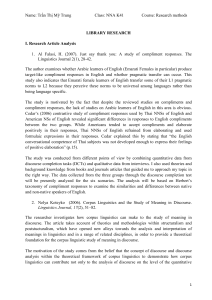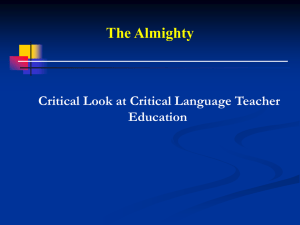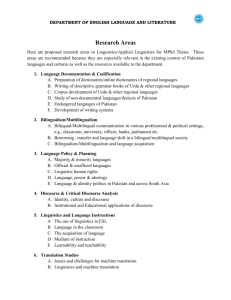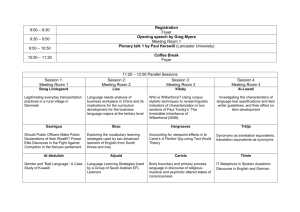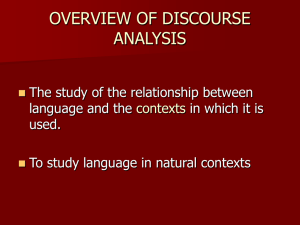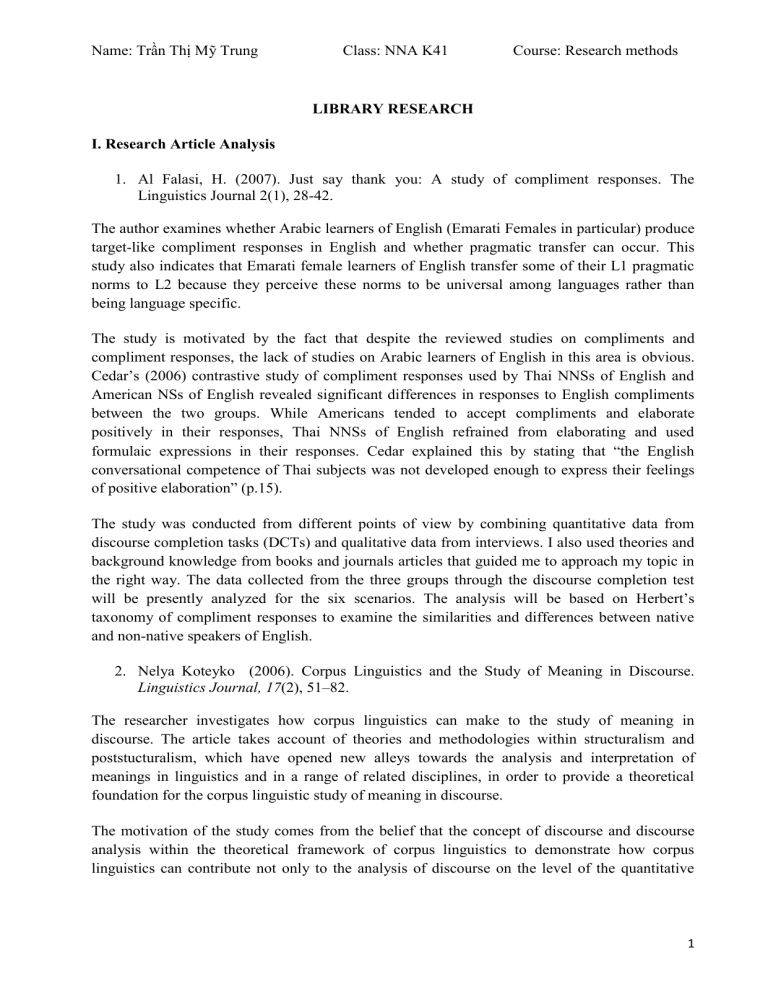
Name: Trần Thị Mỹ Trung Class: NNA K41 Course: Research methods LIBRARY RESEARCH I. Research Article Analysis 1. Al Falasi, H. (2007). Just say thank you: A study of compliment responses. The Linguistics Journal 2(1), 28-42. The author examines whether Arabic learners of English (Emarati Females in particular) produce target-like compliment responses in English and whether pragmatic transfer can occur. This study also indicates that Emarati female learners of English transfer some of their L1 pragmatic norms to L2 because they perceive these norms to be universal among languages rather than being language specific. The study is motivated by the fact that despite the reviewed studies on compliments and compliment responses, the lack of studies on Arabic learners of English in this area is obvious. Cedar’s (2006) contrastive study of compliment responses used by Thai NNSs of English and American NSs of English revealed significant differences in responses to English compliments between the two groups. While Americans tended to accept compliments and elaborate positively in their responses, Thai NNSs of English refrained from elaborating and used formulaic expressions in their responses. Cedar explained this by stating that “the English conversational competence of Thai subjects was not developed enough to express their feelings of positive elaboration” (p.15). The study was conducted from different points of view by combining quantitative data from discourse completion tasks (DCTs) and qualitative data from interviews. I also used theories and background knowledge from books and journals articles that guided me to approach my topic in the right way. The data collected from the three groups through the discourse completion test will be presently analyzed for the six scenarios. The analysis will be based on Herbert’s taxonomy of compliment responses to examine the similarities and differences between native and non-native speakers of English. 2. Nelya Koteyko (2006). Corpus Linguistics and the Study of Meaning in Discourse. Linguistics Journal, 17(2), 51–82. The researcher investigates how corpus linguistics can make to the study of meaning in discourse. The article takes account of theories and methodologies within structuralism and poststucturalism, which have opened new alleys towards the analysis and interpretation of meanings in linguistics and in a range of related disciplines, in order to provide a theoretical foundation for the corpus linguistic study of meaning in discourse. The motivation of the study comes from the belief that the concept of discourse and discourse analysis within the theoretical framework of corpus linguistics to demonstrate how corpus linguistics can contribute not only to the analysis of discourse on the level of the quantitative 1 Name: Trần Thị Mỹ Trung Class: NNA K41 Course: Research methods studies of lexis and syntax but also to discourse analysis aimed at the interpretation of lexical items in a particular context (i.e. studies where discourse is theorised as a complex relationship between language, ideology and society). The focus is on the qualitative analysis of discourse seen as a concrete socio-historical formation characterised by particular ways of using language. In particular, I am interested in the contribution that corpus linguistics can make to the historically-oriented “genealogical” analysis of discourse in the tradition of Foucault. Taking into account theorisations of the concept of discourse in linguistics and social sciences, suggestions are made for underlaying both the synchronic and diachronic aspect of discourse analysis with a principled collection and documentation of data. 3. John Winward (2004). The role of semantic and pragmatic factors in article production by advanced Thai learners. The Linguistics Journal, 6(1), 2012 This research project adopted a framework based on semantic and pragmatic theories which allow very precise predictions to be made of the errors in article production that students from article-less L1 backgrounds will make. The paper is structured as follows. First, the language acquisition model is described, and the predictions that it makes are set out. The paper then examines interlanguage variation, and proposes a description of the acquisition task facing an L2 learner of English whose L1 does not instantiate an article system. Previous research in the field is reviewed, to show how this body of research leads to the hypotheses of the research. Finally, the research itself is described, and findings, conclusions and recommendations reported.. The research is motivated by the problems that Asian students have been facing. This paper will argue that the application of semantic theories, at least to a core range of English DP types, can elucidate this problem by exposing regularities in the pattern of errors that Thai students make. The students who participated in this experiment spanned a range of overall skill levels, from intermediate to advanced learners. The paper is structured as follows. First, the language acquisition model is described, and the predictions that it makes are set out. The paper then examines interlanguage variation, and proposes a description of the acquisition task facing an L2 learner of English whose L1 does not instantiate an article system. Previous research in the field is reviewed, to show how this body of research leads to the hypotheses of the research. Finally, the research itself is described, and findings, conclusions and recommendations reported 4. Jungyoung Park & Richard Schlight (2021). Creative Writing Workshop with Native and Non-native English Speaking Graduate Students: A Comparative Study. The Asian EFL Journal, 25(1), 21-47. The researcher inspects the impact of a creative writing workshop on native versus non-native English speaking graduate students’ perceptions and practice of English writing. It also conducted semi-structured interviews with 11 graduate students of education. 2 Name: Trần Thị Mỹ Trung Class: NNA K41 Course: Research methods The modern writing workshop is difficult to clearly define, not because of a scarcity of definition but rather because of the wide spectrum of its implementation. In order to convey a more complete understanding of the writing workshop, the history, scope and objectives, applications, criticism, and strengths will be overviewed. Using a constant comparative method (Boeije, 2002), this qualitative study drew on semistructured interview data from 11 graduate students as well as their writing samples from the writing workshop. The context of the workshop, its participants, and data collection and analysis procedures are described in detail in the following sections. 5. Phitsinee Koad & Budi Waluyo (2021). What Makes More and Less Proficient EFL Learners? Learner’s Beliefs, Learning Strategies and Autonomy. The Asian EFL Journal, 25(1), 49-78 The primary objective of this study is to investigate individual differences that make more and less proficient Thai EFL learners. Three selected factors for the investigation consist of learners’ beliefs about English language learning, language learning strategies and autonomy. From the findings of previous studies, there is an indication that these three factors are built upon one another. Learners beliefs have been found to be closely related to learning strategies (e.g. Chang & Shen, 2010; Yang, 1999), then learning strategies have currently been connected to learner autonomy (e.g. Chen & Pan, 2015; Oxford, 2008). However, there is still little is known about the interrelationships between learners’ beliefs, learning strategies and autonomy and the roles they play on more and less proficient English learners. This study, thus, aims to provide empirical findings in this research area of interest. The design of this study was quantitative that made use of quantifiable data for data analysis. The central emphasis was on the examination of interrelationships among the variables of interests using various statistical techniques such as Exploratory Factor Analysis (EFA), Independent t-test, and Multiple-Linear Regression applicable for applied linguistics research (Fryer, Larson-Hall & Stewart, 2018). In the examination process, illustrative figures, e.g. histogram and scree plot, were explored, yet not presented in this paper due to the limited number of words. II. Comments on the use of research methods in the five articles In five articles above, there are a multiple types of research methods applied. While the first study was conducted from different points of view by combining quantitative data from discourse completion tasks and qualitative data from interviews, the second one is on the qualitative analysis. Meanwhile, the fourth thesis used descriptive and comparative method and the last one employed quantitative method. 3 Name: Trần Thị Mỹ Trung Class: NNA K41 Course: Research methods The first thing should be considered is that in the first three articles, experiments were conducted, then the outcomes were taken into account and analyzed to present the possible results. However, in articles number four and five, the research questions were put before the investigation and the results were then synthesized and analyzed as well as some comparisons were made. Second, ways of gathering data are not similar. It is shown from the library research that qualitative data are collected through researchers’ observation and analysis of records, and retrospective verbal reports. Also, the research design, focusing mainly on the process, is divided into two stages in both qualitative studies. In contrast, experiment is the main method of collecting data in all three quantitative studies above. Participants in these quantitative experiments, larger in number compared with those in the qualitative articles, are assigned into two groups, namely control group and experimental group. Data are analysed with emphasis on the comparison of performance between the two groups. In conclusion, though there is some similarity in the five analyzed articles, there are still some differences between these methods. These two types of research methods, indeed, are complement to each other in some certain manners. As a result, a combined research method of the two types is widely used in recent studies. Resources: Al Falasi, H. (2007). Just say thank you: A study of compliment responses. The Linguistics Journal 2(1), 28-42. https://www.linguistics-journal.com/2014/01/08/just-say-thank-you-a-study-of-complimentresponses/ Nelya Koteyko (2006). Corpus Linguistics and the Study of Meaning in Discourse. Linguistics Journal, 17(2), 51–82. https://www.linguistics-journal.com/2014/01/09/corpus-linguistics-and-the-study-of-meaning-indiscourse/ John Winward (2004). The role of semantic and pragmatic factors in article production by advanced Thai learners. The Linguistics Journal, 6(1), 127-150 https://www.linguistics-journal.com/wp-content/uploads/2014/01/Volume-6-Issue-1-2012.pdf Jungyoung Park & Richard Schlight (2021). Creative Writing Workshop with Native and Nonnative English Speaking Graduate Students: A Comparative Study. The Asian EFL Journal, 25(1), 21-47. https://www.elejournals.com/asian-efl-journal/volume-25-issue-1-january-2021/ Phitsinee Koad & Budi Waluyo (2021). What Makes More and Less Proficient EFL Learners? 4 Name: Trần Thị Mỹ Trung Class: NNA K41 Course: Research methods Learner’s Beliefs, Learning Strategies and Autonomy. The Asian EFL Journal, 25(1), 49-78 https://www.asian-efl-journal.com/main-editions-new/2021-main-editions/volume-25-issue-1january-2021/ . 5
